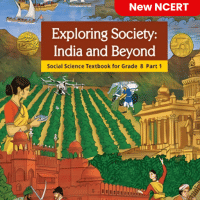Class 8 Exam > Class 8 Questions > The tissue composed of the living, thin-walle...
Start Learning for Free
The tissue composed of the living, thin-walled, polyhedral cell
- a)collenchyma
- b)parenchyma
- c)sclerenchyma
- d)striated muscle
Correct answer is option 'B'. Can you explain this answer?
Most Upvoted Answer
The tissue composed of the living, thin-walled, polyhedral cella)colle...
The tissue composed of the living, thin-walled, polyhedral cell is called parenchyma
Parenchyma is a type of tissue that is made up of living cells with thin cell walls. lt is a simple permanent tissue that makes up a large part of plant-soil tissues. parenchyma is non-vascular and is made up of cells that are basic, living, and undifferentiated. These cells are modified to perform various functions
Parenchyma is a type of tissue that is made up of living cells with thin cell walls. lt is a simple permanent tissue that makes up a large part of plant-soil tissues. parenchyma is non-vascular and is made up of cells that are basic, living, and undifferentiated. These cells are modified to perform various functions
Free Test
FREE
| Start Free Test |
Community Answer
The tissue composed of the living, thin-walled, polyhedral cella)colle...
The tissue composed of the living, thin-walled, polyhedral cell is parenchyma.
Parenchyma is a type of simple permanent tissue found in plants. It is composed of living cells that have thin walls and are usually polyhedral in shape. Parenchyma cells are the most common type of plant cells and can be found in various parts of the plant, including the leaves, stems, roots, and fruits.
Characteristics of Parenchyma tissue:
1. Living cells: Parenchyma cells are living cells that are capable of performing various metabolic functions such as photosynthesis, storage, secretion, and gas exchange.
2. Thin-walled: The cell walls of parenchyma cells are thin and flexible, allowing for easy exchange of gases and nutrients.
3. Polyhedral shape: Parenchyma cells are usually polyhedral in shape, meaning they have multiple sides or faces. This shape allows for close packing of cells and efficient use of space.
4. Large central vacuole: Parenchyma cells often contain a large central vacuole, which helps in storage of water, nutrients, and waste products.
Functions of Parenchyma tissue:
1. Photosynthesis: Parenchyma cells in the leaves contain chloroplasts and are involved in the process of photosynthesis, producing food for the plant.
2. Storage: Parenchyma cells in various plant organs, such as the roots, stems, and fruits, store nutrients, water, and other substances for the plant's growth and development.
3. Secretion: Some parenchyma cells are specialized for secretion of substances like nectar, resin, latex, and oils.
4. Gas exchange: Parenchyma cells in the leaves and stems have air spaces between them, allowing for the exchange of gases such as oxygen and carbon dioxide.
Types of Parenchyma tissue:
1. Chlorenchyma: This type of parenchyma tissue contains chloroplasts and is involved in photosynthesis. It is commonly found in the mesophyll of leaves.
2. Aerenchyma: Aerenchyma is a specialized type of parenchyma tissue with large air spaces that allow the plant to float or respire in waterlogged conditions.
3. Storage parenchyma: This type of parenchyma tissue is involved in the storage of water, starch, proteins, and other substances. It is commonly found in roots, stems, and fruits.
In conclusion, the tissue composed of the living, thin-walled, polyhedral cell is parenchyma. Parenchyma tissue is important for various functions in plants, including photosynthesis, storage, secretion, and gas exchange.
Parenchyma is a type of simple permanent tissue found in plants. It is composed of living cells that have thin walls and are usually polyhedral in shape. Parenchyma cells are the most common type of plant cells and can be found in various parts of the plant, including the leaves, stems, roots, and fruits.
Characteristics of Parenchyma tissue:
1. Living cells: Parenchyma cells are living cells that are capable of performing various metabolic functions such as photosynthesis, storage, secretion, and gas exchange.
2. Thin-walled: The cell walls of parenchyma cells are thin and flexible, allowing for easy exchange of gases and nutrients.
3. Polyhedral shape: Parenchyma cells are usually polyhedral in shape, meaning they have multiple sides or faces. This shape allows for close packing of cells and efficient use of space.
4. Large central vacuole: Parenchyma cells often contain a large central vacuole, which helps in storage of water, nutrients, and waste products.
Functions of Parenchyma tissue:
1. Photosynthesis: Parenchyma cells in the leaves contain chloroplasts and are involved in the process of photosynthesis, producing food for the plant.
2. Storage: Parenchyma cells in various plant organs, such as the roots, stems, and fruits, store nutrients, water, and other substances for the plant's growth and development.
3. Secretion: Some parenchyma cells are specialized for secretion of substances like nectar, resin, latex, and oils.
4. Gas exchange: Parenchyma cells in the leaves and stems have air spaces between them, allowing for the exchange of gases such as oxygen and carbon dioxide.
Types of Parenchyma tissue:
1. Chlorenchyma: This type of parenchyma tissue contains chloroplasts and is involved in photosynthesis. It is commonly found in the mesophyll of leaves.
2. Aerenchyma: Aerenchyma is a specialized type of parenchyma tissue with large air spaces that allow the plant to float or respire in waterlogged conditions.
3. Storage parenchyma: This type of parenchyma tissue is involved in the storage of water, starch, proteins, and other substances. It is commonly found in roots, stems, and fruits.
In conclusion, the tissue composed of the living, thin-walled, polyhedral cell is parenchyma. Parenchyma tissue is important for various functions in plants, including photosynthesis, storage, secretion, and gas exchange.

|
Explore Courses for Class 8 exam
|

|
Question Description
The tissue composed of the living, thin-walled, polyhedral cella)collenchymab)parenchymac)sclerenchymad)striated muscleCorrect answer is option 'B'. Can you explain this answer? for Class 8 2025 is part of Class 8 preparation. The Question and answers have been prepared according to the Class 8 exam syllabus. Information about The tissue composed of the living, thin-walled, polyhedral cella)collenchymab)parenchymac)sclerenchymad)striated muscleCorrect answer is option 'B'. Can you explain this answer? covers all topics & solutions for Class 8 2025 Exam. Find important definitions, questions, meanings, examples, exercises and tests below for The tissue composed of the living, thin-walled, polyhedral cella)collenchymab)parenchymac)sclerenchymad)striated muscleCorrect answer is option 'B'. Can you explain this answer?.
The tissue composed of the living, thin-walled, polyhedral cella)collenchymab)parenchymac)sclerenchymad)striated muscleCorrect answer is option 'B'. Can you explain this answer? for Class 8 2025 is part of Class 8 preparation. The Question and answers have been prepared according to the Class 8 exam syllabus. Information about The tissue composed of the living, thin-walled, polyhedral cella)collenchymab)parenchymac)sclerenchymad)striated muscleCorrect answer is option 'B'. Can you explain this answer? covers all topics & solutions for Class 8 2025 Exam. Find important definitions, questions, meanings, examples, exercises and tests below for The tissue composed of the living, thin-walled, polyhedral cella)collenchymab)parenchymac)sclerenchymad)striated muscleCorrect answer is option 'B'. Can you explain this answer?.
Solutions for The tissue composed of the living, thin-walled, polyhedral cella)collenchymab)parenchymac)sclerenchymad)striated muscleCorrect answer is option 'B'. Can you explain this answer? in English & in Hindi are available as part of our courses for Class 8.
Download more important topics, notes, lectures and mock test series for Class 8 Exam by signing up for free.
Here you can find the meaning of The tissue composed of the living, thin-walled, polyhedral cella)collenchymab)parenchymac)sclerenchymad)striated muscleCorrect answer is option 'B'. Can you explain this answer? defined & explained in the simplest way possible. Besides giving the explanation of
The tissue composed of the living, thin-walled, polyhedral cella)collenchymab)parenchymac)sclerenchymad)striated muscleCorrect answer is option 'B'. Can you explain this answer?, a detailed solution for The tissue composed of the living, thin-walled, polyhedral cella)collenchymab)parenchymac)sclerenchymad)striated muscleCorrect answer is option 'B'. Can you explain this answer? has been provided alongside types of The tissue composed of the living, thin-walled, polyhedral cella)collenchymab)parenchymac)sclerenchymad)striated muscleCorrect answer is option 'B'. Can you explain this answer? theory, EduRev gives you an
ample number of questions to practice The tissue composed of the living, thin-walled, polyhedral cella)collenchymab)parenchymac)sclerenchymad)striated muscleCorrect answer is option 'B'. Can you explain this answer? tests, examples and also practice Class 8 tests.

|
Explore Courses for Class 8 exam
|

|
Signup for Free!
Signup to see your scores go up within 7 days! Learn & Practice with 1000+ FREE Notes, Videos & Tests.























